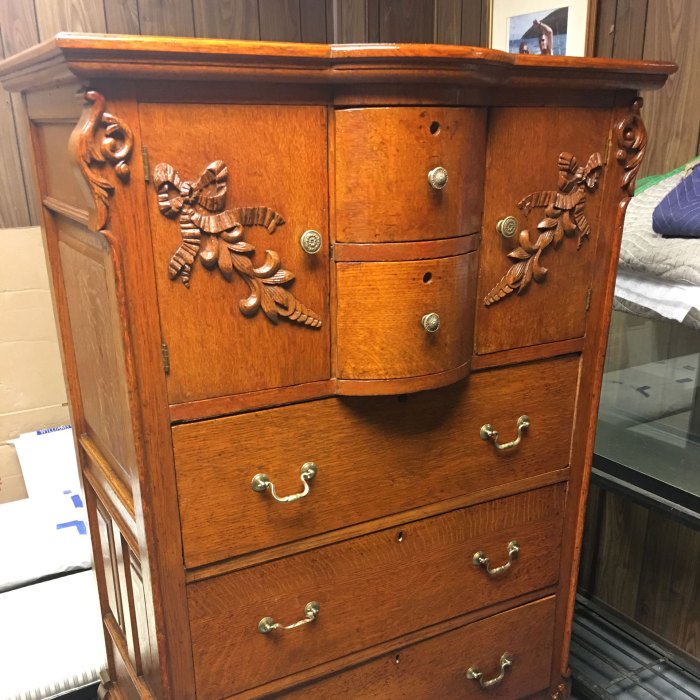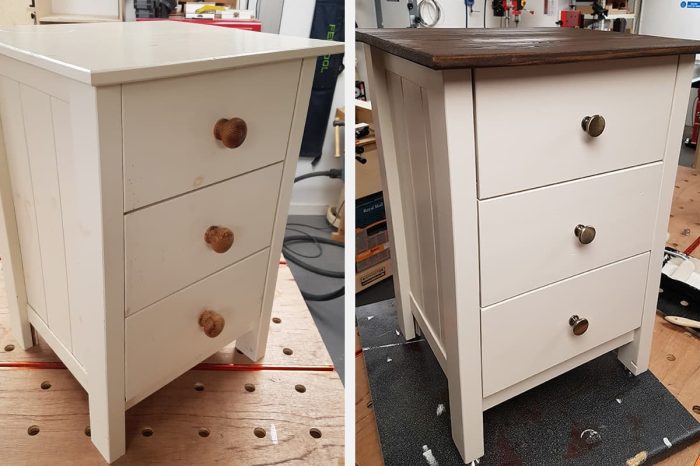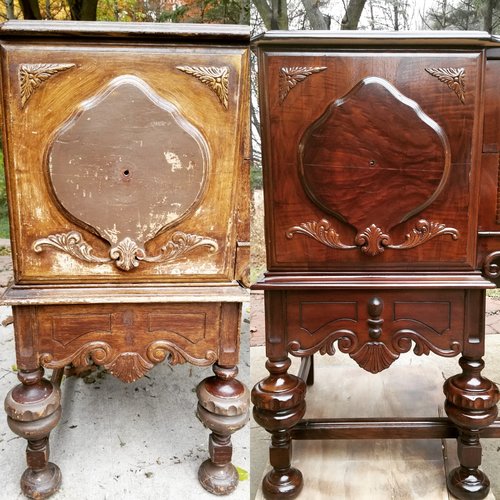Vintage bathroom furniture holds a unique charm that transcends time, offering a touch of nostalgia and character to any space. Restoring these pieces not only preserves their beauty but also allows you to create a bathroom with a distinctive personality.
This guide will provide you with comprehensive tips and techniques to breathe new life into your vintage bathroom furniture, transforming it into a centerpiece of your décor.
Whether you’re a seasoned DIY enthusiast or a novice looking to embark on a restoration project, this guide will equip you with the knowledge and confidence to tackle any challenge. From identifying the right pieces to choosing the appropriate restoration methods and materials, we’ll cover every aspect of the restoration process.
So, let’s dive in and explore the art of restoring vintage bathroom furniture, bringing back its former glory and adding a touch of timeless elegance to your bathroom.
Introduction
Vintage bathroom furniture adds a touch of elegance and nostalgia to any bathroom. These pieces are often made from high-quality materials and feature intricate details that are no longer found in modern furniture.
If you’re looking to add a unique touch to your bathroom, vintage furniture is a great option. Here are a few tips on how to find and restore vintage bathroom furniture:
Finding Vintage Bathroom Furniture
- Check online marketplaces. Websites like eBay and Etsy are great places to find vintage bathroom furniture. You can often find good deals on these sites, but be sure to read the descriptions carefully and ask the seller any questions you have before you buy.
- Visit antique stores. Antique stores are another great place to find vintage bathroom furniture. The prices at antique stores can be higher than online marketplaces, but you’ll have the opportunity to see the furniture in person before you buy it.
- Attend flea markets. Flea markets are a great place to find unique and affordable vintage furniture. However, it’s important to inspect the furniture carefully before you buy it, as it may not be in perfect condition.
Restoration Methods
Vintage bathroom furniture restoration involves a variety of techniques to restore its original beauty and functionality. Choosing the appropriate method depends on the furniture’s condition, material, and desired outcome.
Refinishing
Refinishing involves removing the old finish and applying a new one. This method is suitable for furniture with damaged or worn finishes, such as scratches, chips, or discoloration. The process includes stripping, sanding, staining, and sealing the furniture.
- Stripping: Use a chemical stripper to remove the old finish. Follow the manufacturer’s instructions carefully to avoid damage to the wood.
- Sanding: Sand the furniture to remove any remaining old finish and smooth the surface. Use different grits of sandpaper, starting with a coarse grit and gradually moving to a finer grit.
- Staining: Apply a stain to match the original color of the furniture or create a new look. Allow the stain to dry thoroughly.
- Sealing: Apply a protective finish, such as polyurethane or varnish, to protect the furniture from wear and tear.
Repainting
Repainting involves applying a new coat of paint over the existing finish. This method is suitable for furniture with a sound finish that needs a color refresh or to match a new bathroom décor. The process includes cleaning, sanding, priming, and painting the furniture.
- Cleaning: Clean the furniture thoroughly to remove any dirt or grease.
- Sanding: Lightly sand the furniture to create a smooth surface for the paint to adhere to.
- Priming: Apply a primer to help the paint adhere better and prevent the old finish from bleeding through.
- Painting: Apply multiple coats of paint, allowing each coat to dry thoroughly before applying the next.
Reupholstering
Reupholstering involves replacing the fabric or leather on upholstered furniture. This method is suitable for furniture with damaged or worn upholstery. The process includes removing the old upholstery, repairing or replacing any damaged padding, and applying new fabric or leather.
- Removing the old upholstery: Carefully remove the old fabric or leather using a staple remover or pliers.
- Repairing or replacing the padding: Inspect the padding for any damage or wear. Replace or repair as needed.
- Applying new fabric or leather: Stretch the new fabric or leather over the furniture and secure it with staples or upholstery tacks.
Materials and Tools
Gathering the appropriate materials and tools is crucial for successful vintage bathroom furniture restoration. Understanding the specific requirements of each restoration method will guide your choices.
Selecting the right materials ensures compatibility with the original design and the desired outcome. Tools should be chosen based on their functionality and suitability for the task at hand.
Materials
- Wood filler: Used to fill gaps and cracks in wood surfaces. Choose a filler that matches the wood color and grain.
- Sandpaper: Available in various grits, used for smoothing surfaces, removing old finishes, and creating a smooth base for new finishes.
- Paint or stain: Choose a paint or stain that complements the original finish or creates a desired new look. Consider the original finish and the overall style of the bathroom.
- Hardware: Replace worn or missing hardware with new pieces that match the original style or complement the new finish.
- Fabric or upholstery: For reupholstering cushions or curtains, choose fabrics that are durable and aesthetically pleasing.
Tools
- Sanding block: Provides a flat surface for sanding and ensures even results.
- Paintbrush or roller: Used for applying paint or stain smoothly and evenly.
- Screwdriver or drill: Necessary for removing and installing hardware.
- Upholstery needle and thread: For reupholstering cushions or curtains.
- Safety glasses and gloves: Essential for protecting yourself during restoration work.
Troubleshooting Common Problems
Vintage bathroom furniture restoration can present unique challenges. Here are some common problems that may arise and their solutions:
Warped or Buckling Wood
- Problem: Wood has warped or buckled due to moisture or temperature changes.
- Solution: Remove the wood and place it in a cool, dry environment with good air circulation. Use weights or clamps to flatten it.
- Prevention: Keep the furniture in a stable environment with controlled humidity and temperature.
Loose Joints
- Problem: Joints have become loose due to age or wear.
- Solution: Tighten the joints using wood glue and clamps. If necessary, reinforce the joints with dowels or screws.
- Prevention: Regularly check the joints and tighten them as needed.
Rust or Corrosion
- Problem: Metal components have rusted or corroded.
- Solution: Remove the rust or corrosion using a wire brush or sandpaper. Apply a rust-resistant primer and paint.
- Prevention: Protect metal components from moisture and use rust-resistant materials.
Faded or Damaged Finish
- Problem: The finish has faded or become damaged due to exposure to sunlight or chemicals.
- Solution: Remove the old finish using a chemical stripper or sandpaper. Apply a new finish that matches the original color and sheen.
- Prevention: Use a UV-resistant finish and avoid placing the furniture in direct sunlight.
Finishing Touches
Once you’ve restored your vintage bathroom furniture to its former glory, it’s time to add the finishing touches. These touches can help to protect your furniture, enhance its appearance, and make it more functional.
When choosing finishing touches, it’s important to consider the style of your furniture. For example, if you have a classic clawfoot bathtub, you might want to choose a traditional finish such as a white or black enamel. If you have a more modern bathroom, you might want to choose a more contemporary finish such as a brushed nickel or chrome.
Hardware
One of the most important finishing touches is the hardware. The hardware can include things like knobs, pulls, and hinges. When choosing hardware, it’s important to consider the size, shape, and finish of the furniture. You’ll also want to make sure that the hardware is durable and easy to use.
Sealing
Once you’ve chosen your finishing touches, it’s important to seal them. Sealing will help to protect the finish from water and wear. There are a variety of different sealants available, so be sure to choose one that is appropriate for the type of finish you’ve chosen.
Maintenance and Care
Preserving the beauty and longevity of your restored vintage bathroom furniture requires proper maintenance and care. By following these simple tips, you can prevent damage and ensure its charm endures for years to come.
Establish a regular cleaning routine to remove dust, dirt, and moisture. Use a soft, damp cloth and mild detergent, avoiding harsh chemicals or abrasive materials. Dry the surface thoroughly after cleaning to prevent water damage.
Protection from Moisture
Bathroom environments are prone to moisture, which can damage furniture if not addressed. Keep your furniture away from direct water sources like showers or sinks. Consider using a bathroom fan or dehumidifier to control humidity levels. Wipe up any spills immediately to prevent water penetration.
Avoid Harsh Chemicals
Cleaning products containing harsh chemicals can damage the finish of your furniture. Stick to mild detergents and avoid using bleach or ammonia-based cleaners. Test any cleaning solutions on an inconspicuous area first to ensure compatibility.
Maintenance Schedule
Regular maintenance is key to extending the life of your vintage bathroom furniture. Here’s a suggested maintenance schedule:
- Daily: Clean surfaces with a soft, damp cloth.
- Weekly: Wipe down surfaces with a mild detergent solution.
- Monthly: Inspect furniture for any signs of damage or wear.
- Annually: Apply a protective wax or polish to the surface to enhance its durability.
Closure
Restoring vintage bathroom furniture is a rewarding endeavor that allows you to preserve the charm of the past while creating a unique and stylish bathroom space. By following the tips and techniques Artikeld in this guide, you can breathe new life into these cherished pieces, ensuring they continue to grace your bathroom for years to come.
Remember, the beauty of vintage bathroom furniture lies in its imperfections, so embrace the patina of time and let the restored pieces tell a story of their own.



